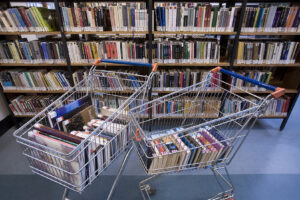According to the PR Department of NLAI, on Monday, 24 of August, Ashraf Boroujerdi, the Chairwoman of NLAI announced the unveiling and launch of National Iranian Memory and SANA systems in a press conference held following COVID-19 safety protocols.
NIM System: Realizing Dream of Free Access to Iran’s Historical Data
Commemorating the Government Week, she added, “The government is constantly struggling to boost public awareness and social progress through transfer of information and ease of access. The development of e-government has always been a focus of President Rouhani’s administration. Accordingly, the National Library and Archives of I.R. Iran is obliged to provide its information to the public, scholars, researchers, and everyone who relies on this organization as an academic source.”
Head of NLAI remarked: “This objective has been promoted at different levels by this administration and has extended to include all sectors. Given its mission, NLAI has taken effective steps in setting strategies to improve and optimize its service using new technologies, since one of the duties of the organization is to interpret, explain, and justify services for transfer of knowledge across the community.”
Boroujerdi explained that NLAI has been known as the National Iranian Memory for a long time and added that NLAI’s heritage include intellectual assets, science and scholarly beliefs, and also events and incidents of time.
She continued: “NLAI is the protector of an invaluable common heritage of mankind and, therefore, we have done our best to change this organization’s rigid approach and the idea that the documents and resources belong to the organization. Researchers and scientists are always searching for data and new information only to find them inaccessible. NLAI is trying to make these resources available to all researchers and book and science lovers.”
Pointing to NLAI’s slogan, Boroujerdi stated that NLAI believes in its slogan of ‘the national library in the home of every Iranian’, and considers it a primary objective which governs the initiation and execution of many of its programs and projects.”
Head of NLAI addressed the launch of NIM and SANA systems, saying that these systems were envisioned and launched aiming to enrich user experience and facilitate a fair distribution of information and journals. The project is planned in multiple phases and will hopefully be preserved for future generations.”
She also added that there are currently 3,000 libraries linked to this system and their resources are received and then made available to the public via an integrated network.
To further describe the Iranian Bank of Journals, Boroujerdi continued, “The National Library and Archives of I.R. Iran has compiled a list of its manuscript resources in recent years, titled FANKHA (list of Iranian manuscripts). Next, the list of all Farsi manuscript books both in Iran and the world was acquired from 1,868 databases, and accordingly, the list of 1,014,000 Farsi manuscripts was uploaded to the system.”
She stated that today, the Iranian Bank of Journals offers about 64,000 magazines, journals, and bulletins available to the public.
Concerning the National Archives Network, she added, “After launching this system, all related centers were convinced and notified how to make the basic information of their documents available to NLAI, which will shape and enhance the national database. Still, further cooperation is needed in this area as many documents are in the possession of ancient families, and there are ongoing negotiations in this regard.”
Emphasizing how the launch of this system can be a significant contribution to supporting the National Iranian Memory, she added, “We are attempting to bring libraries and archives under the same standard.”
Nowruz Technological Development Group was the implementer of the National Iranian Memory system for the National Library and Archives of I.R. Iran.
Source: NLAI website




